








The fascinating legend of Hibashi Lava Tube: is it true?
        |

The fascinating legend of Hibashi Lava Tube: is it true?
|
PHOTOS BY JOHN PINT EXCEPT WHERE OTHERWISE INDICATED - © 2005 by John and Susy Pint Revised 2013
“Man Survives Deadly Cave Ordeal for Twenty Days”
The headline was worthy of a supermarket tabloid. A man had wandered into Ghar Al Hibashi, located deep inside Arabia’s Al Buqum lava field. He had battled ferocious wolves and hyenas, breathed poisonous fumes and endured the bites of disease-laden bugs, all this while trapped inside the cave for nearly three weeks. During his ordeal, he had eaten grass, drunk “cave water” and stumbled around in the dark until he surfaced through a hole located 17 kms from the cave entrance. Such a cave appeared worthy of investigation, even if it turned out only one tenth as long as the newspaper claimed.
During the first week of January, 2003, we set out on our quest. All we knew about the cave’s location was that it lay somewhere between Ranyah and Turubah… that meant a mere 130-km stretch of tire-eating lava to check out. “I think I’ll sit this one out,” Susy had commented, “until you actually FIND the cave… if it’s really a cave at all.”
For this trip, we had two Land Cruisers, fitted with nearly worthless Dunlop tires – and a large truck big enough to carry several of the pickups SGS usually assigns us.
Ten and a half hours after setting out from Jeddah, we were still nowhere near the cave and the sun was about to set. Since you can’t find a black hole in black lava in the dark, we pulled off a nice wide track we had just discovered and began to make camp near the mangled remains of a tanker.
A ROAR IN THE DARK
As usual, I picked a spot far from the camp to set up my tent, knowing how late the others usually stay up. I found a patch of sand between some lava chunks and thorn bushes and had just finished putting on the rain fly when I heard a very strange sound in the total darkness, somewhere far behind me. It was a long, slow, throaty growl and it made the small hairs on the back of my neck stand straight up in fear. Then I heard it again, this time a lot closer.
I couldn’t believe my ears as it sounded exactly like a lion, but there haven’t been any lions in western Arabia for thousands of years.
The rumbling growl came again, even closer. Could it be a wolf? There are definitely plenty of wolves in these parts. I edged away from the tent and carefully made my way back to the cars. Without a doubt, there was something weird out there!
I told Mahmoud I thought I had heard a lion and he gave me a very peculiar look. Then he asked everyone to shut up and he heard it too. His eyes bulged and he walked over to the truck and picked up a heavy metal pipe. The whole gang of us now tiptoed behind Mahmoud as he very carefully made his way toward my tent. Suddenly, we saw a movement in the beams of our collective flashlights.
THREE SOMALIS FAR FROM HOME
We spent a very cold night and the next morning at breakfast, I took one of the cave thermometers out of the watertight box it was stored in. The reading was 5 degrees C and I suspect that during the night it must have been just above zero C.
After breaking camp, we found some local people who gave us a rough idea of how we could find our way to Jebel Hibashi, near which—we assumed—we’d find our cave.
Amazingly, we drove a few meters to the top of a low rise and from there saw, in the distance, several large white tents, neatly arranged all in a row. Bedus!
As usual, a couple of these astoundingly generous people immediately volunteered to lead us to the cave, which they said was nearby.
UNDERGROUND HOTEL
|
|
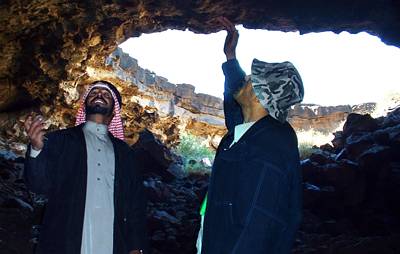 |
There was just one slight problem. As so often happens, somebody had decided this cave was a fine place to throw his dead sheep, and there were three bloated carcasses perfuming the air of our new home. Fortunately, there were sandy spots near the sheep, so I decided to abandon the chain gang and bury the bodies. This turned out to be more of a job than I had figured, but in the end it was well worth it as our new home smelled as lovely… well, as lovely as you could ever expect a cave to smell.
WALL TO WALL CARPETING
Which brings me to the subject of the cave floor on which we spread our carpets and tarps. This lava tube, like all the others we’ve seen in this country has a deep layer of powdery sediment covering the original floor. Now, a dirt floor would not be bad to camp on, but this first room of the cave had obviously been used as an animal corral in the past. Most of us thought goats had lived here, but Abdulrahman, our resident Bedu, declared that the billions of little balls on which we were camping had been produced by sheep, over a long, long period of time, I should guess.
We put on our helmets and picked up a Coleman lamp because the great size of the passage facing us – plus the flat floor – suggested this was going to be an easy-walking cave. We also took along a couple of stout sticks because we had spotted the large imprint of an unknown, five-toed animal’s paw on the ground.
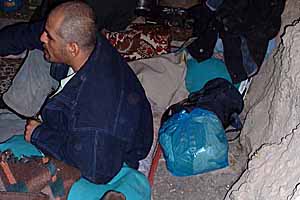 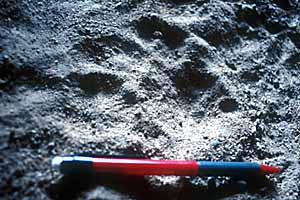
On the left, our sheep-dung carpet and on the right, a ,mysterious paw print... Could it be the Arabian lion again? |
DRIBBLES AND DIRT
BURNT CAVE
A few steps further, the floor suddenly turned to ash. Bones and even rocks lying on this light-grey surface were charred on the bottom but not on top. The burnt area covered a large part of the cave and appears to be a layer of guano that caught fire and smoldered for a long time.
Some parts of the ceiling in this area are covered with a shiny, very thin coating of black “tar” caused by this fire, We had seen several small wood fires on the floors of various passages in this cave, perhaps used for lighting purposes and it may have been one of these that set the guano on fire… but how long ago? The tar ceiling was also dotted with tan-colored stalactites of a rather soft, sticky substance. At first we thought they were somehow connected with the guano fire, but later we found many more of them on the ceiling of a chamber filled with unburnt guano, so perhaps these are a by-product of bat urine sprayed on the ceiling. We hope a chemical analysis will explain the mystery.
An interesting feature of this cave is a very large, well-shaped dome with the usual high heap of large chunks of breakdown beneath it. We placed a hygrometer and mini-max thermometer in this area and got 48 degrees humidity and a pleasant temperature range of 22-24 degrees Celsius.
THE MURDERED MAIDEN
The next day, the three geologists mapped a large part of the cave while I went around taking photos. They got the worst end of this arrangement because three people stir up a lot more dust than one and all of them returned to Jeddah with bad coughs and burning throats. But by being off on my own, I missed the most exciting find of the whole trip. Deep inside the cave, Abdulrahman found a large rock upon which someone had placed two parts of a human skull. Because the cave has had vandalic visitors in recent times (thanks to that wildly exaggerated newspaper article) and because the skull parts were no longer in situ, it was decided to remove them from the cave for handing over to the proper authorities. We have already had enough experience with skulls and artifacts vanishing because we left them where we found them.
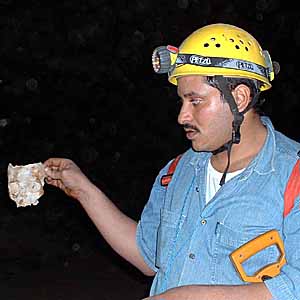 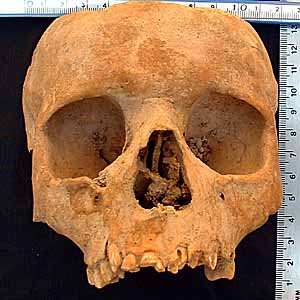
Expert advice, sent to us by email, suggests this was the skull of a young woman who may have been murdered. |
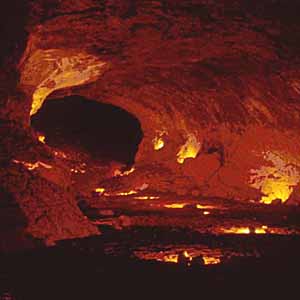 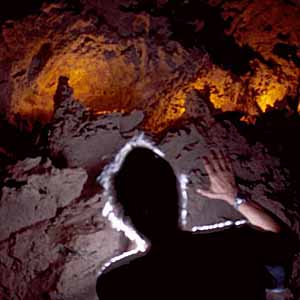
CAVES BY CANDLE LIGHT Here are our first attempts to do cave photography by votive lights. This was Mahmoud's idea, so we should call this the Shanti System. |
We in the Land Cruisers had only one flat on the way back – a miracle, considering that our tires were paper-thin. The truck fared worse, we learned later. Apparently most of its six tires fell to pieces on the way back after that beating in the lava field and it took the driver days to reach Jeddah.
Upon our arrival home, we sent pictures of the skull to various knowledgeable people by email. “It is a human skull,” they assured us, “and the teeth indicate it was a young woman 12 to 18 years old… and didn’t you notice that the brainpan has been sliced off?” So it seems this skull tells us a story of foul play. Perhaps carbon dating will tell us just when it took place.
We found neither wolves nor biting bugs nor poisonous fumes nor grass nor seventeen-kilometer passages in Hibashi Cave, but we did find enough other things to start a few legends of our own.
John Pint